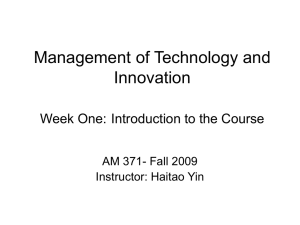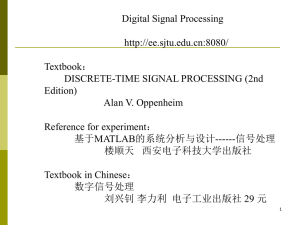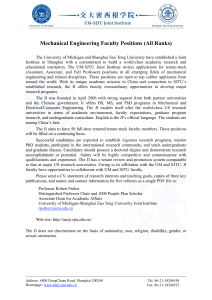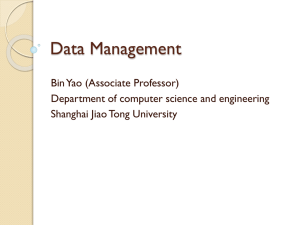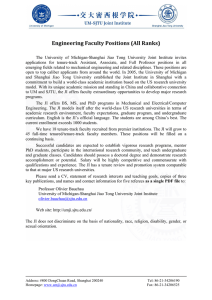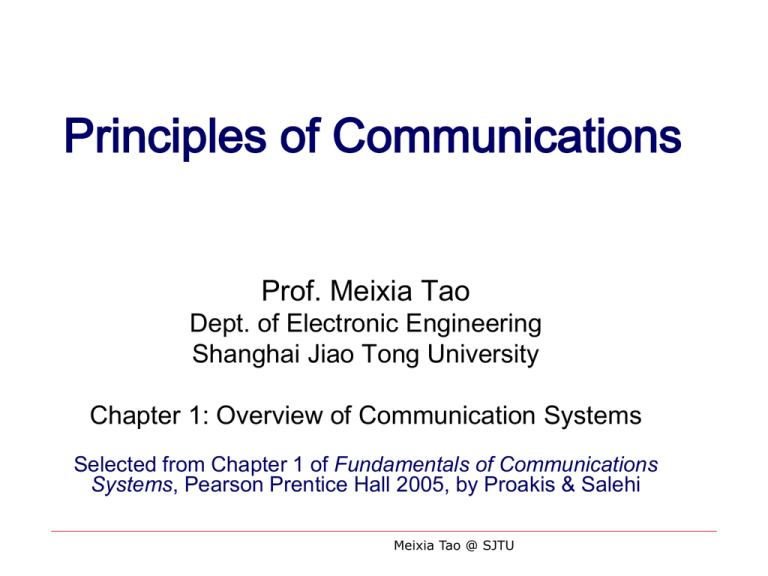
Principles of Communications
Prof. Meixia Tao
Dept. of Electronic Engineering
Shanghai Jiao Tong University
Chapter 1: Overview of Communication Systems
Selected from Chapter 1 of Fundamentals of Communications
Systems, Pearson Prentice Hall 2005, by Proakis & Salehi
Meixia Tao @ SJTU
Staff
Lecturer:
Meixia Tao (陶梅霞)
o
o
o
o
Office: Room 5-301A, SEIEE Building
Tel: 3420-7494-8004
Email: mxtao@sjtu.edu.cn
Web: http://iwct.sjtu.edu.cn/personal/mxtao/
TA:
TBD
Meixia Tao @ SJTU
2
Textbook
Lecture Nodes (Very Important!):
http://iwct.sjtu.edu.cn/personal/mxtao/teaching.html
J. G. Proakis, 2005
樊昌信改编, 2007
Meixia Tao @ SJTU
3
References
“An introduction to analog and digital
communications”, by Simon Haykin, 2nd edition,
John Wiley & Sons, 2007
《通信原理》,韩声栋、蒋铃鸽、刘伟 编著,
机械工业出版社, 2008.6
通信原理实验,杨宇红,袁焱,李安琪,陈大华,
自编教材
Meixia Tao @ SJTU
4
Objective
The primary objective of this course is
to introduce the basic techniques used in modern
communication systems, and
to provide fundamental tools and methodologies in
analysis and design of these systems
After this course, the students are expected to
Understand the principles and technique of modulation,
coding and transmission.
Analyze the merits and demerits of current
communication systems and to eventually design
improved new systems
Meixia Tao @ SJTU
5
Syllabus (1/2)
Ch01:Introduction (1week)
Ch02:Signal, random process, and spectra (2 weeks)
Ch03: Analog modulation (2 weeks)
Ch04: Analog to digital conversion (1 week)
Ch05: Digital transmission through baseband channels (2 weeks)
Ch06: Signal space presentation (1 week)
Ch07: Optimal receivers (1 week)
Ch08: Digital modulation techniques (2 weeks)
Ch09: Information theory (1week)
Ch10: Channel Coding (1 week)
Ch11: Synchronization (1 week)
Meixia Tao @ SJTU
6
Syllabus (2/2)
NI LabVIEW+USRP
Lab 1: Analog modulation
Lab 2: Binary digital modulation techniques
Lab 3: BPSK/QPSK-modulated wireless transmission system
Meixia Tao @ SJTU
7
Assessment
Homework: 15%
Labs: 15%
3 Lab reports + on-site demonstration
Mid-term Test: 10%
5 sets of homework
5-level grading (A+, A, B+, B, C) for each homework
In-class open-book test
Final Exam: 60%
Meixia Tao @ SJTU
8
What is Communication?
“The
systems and processes that are used to convey
information from a source to a destination efficiently and
reliably, especially by means of electricity or radio waves.”
Meixia Tao @ SJTU
Historical Review
1838: telegraph (S. Morse)
1876: telephone (A. Bell)
1895: radio by Marconi
1901: trans-atlantic
communication
Early 20th century:
Nobel Prize for Physics (1909)
Most communication systems are analog.
Engineering designs are ad-hoc, tailored for each
specific application
Meixia Tao @ SJTU
10
Modern Communication Systems
Meixia Tao @ SJTU
11
Fundamental Questions
Is there a general methodology for designing communication systems?
Is there a limit to how fast one can
communicate?
Meixia Tao @ SJTU
12
Harry Nyquist (1928)
"Certain topics in telegraph transmission
theory", Trans. AIEE, vol. 47, pp. 617–
644, Apr. 1928
Sampling Theorem
Continuous-time
Discrete-time
Meixia Tao @ SJTU
13
Claude Shannon (1948)
"A Mathematical Theory of Communication",
Bell System Technical Journal. 1948
Information Theory
Fundamental limits of source compression rate and channel
transmission rate
Analog
communication
Digital
communication
Meixia Tao @ SJTU
14
Basic Elements of Communications
Information
source
Output
signal
Input
Transducer
Transmitter
Channel
Receiver
Output
Transducer
A slight variation from Shannon’s diagram of a general
communication system
Meixia Tao @ SJTU
15
Communication Channels
Common characteristics
Attenuation
Channel
Distortion
Meixia Tao @ SJTU
Noise
16
Wireless Electromagnetic Channels
Meixia Tao @ SJTU
17
Radio Spectrum
Meixia Tao @ SJTU
18
Radio Spectrum
Meixia Tao @ SJTU
19
Propagation
Free-space propagation model
: transmit power
: receive antenna gain
: receive power
: wavelength
: transmit antenna gain
: distance
100 meters
Receives 1/4
of the power
200 meters
Meixia Tao @ SJTU
20
Mathematical Models
The additive noise channel
r=
(t ) s (t ) + n(t )
+
s (t )
n(t )
Linear filter channel
s (t )
h(t )
r (t ) = s (t ) ∗ h(t ) + n(t )
+
=
n(t )
∫
∞
0
h(τ ) s (t − τ )dτ + n(t )
Meixia Tao @ SJTU
21
Linear time-variant filter channel
s (t )
h(τ ; t )
r (t ) =
s (t ) ∗ h(τ ; t ) + n(t )
+
=
n(t )
∫
∞
−∞
h(τ ; t ) s (t − τ )dτ + n(t )
Consider a multi-path signal propagation
=
h(τ ; t )
L
∑ a (t )δ (t − τ
k =1
k
k
)
Meixia Tao @ SJTU
22
Types of Communications Systems
Analog Communications
Digital Communications
00011011110
Meixia Tao @ SJTU
23
Analog Communication Systems
Transmitter
Source
Modulator
Noise
Output
Channel
Detector
Receiver
Meixia Tao @ SJTU
24
Digital Communication Systems
Transmitter
Source
A/D
converter
Source
encoder
Channel
encoder
Absent if
source is
digital
User
D/A
converter
Modulator
Noise
Source
decoder
Channel
decoder
Receiver
Meixia Tao @ SJTU
Detector
Channel
Why Digital Communications?
Robustness to channel noise
and external Interference
Security of information during its
transmission from source to destination
Integration of diverse sources
information into a common format
Low cost DSP chips
by very cheap VLSI designs
Meixia Tao @ SJTU
26
Performance Metrics of Communication
Systems
Reliability
SNR for analog systems
Bit error rate for digital systems
Efficiency
Bandwidth efficiency
Energy efficiency
Performance Tradeoff
Meixia Tao @ SJTU
27
Bandwidth Efficiency
data rate R
bits/sec/Hz
bandwidth efficiency =
bandwidth W
Meixia Tao @ SJTU
28
Energy Efficiency
bit energy
energy efficiency =
= Eb/No
noise power spectral density
Meixia Tao @ SJTU
29

